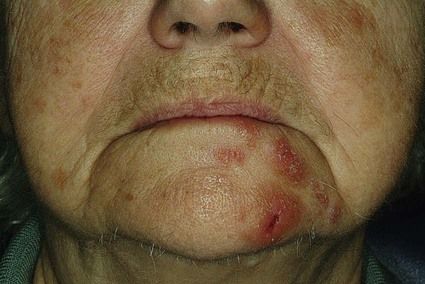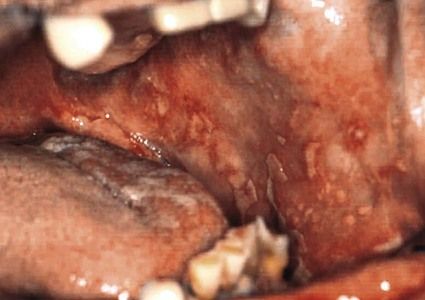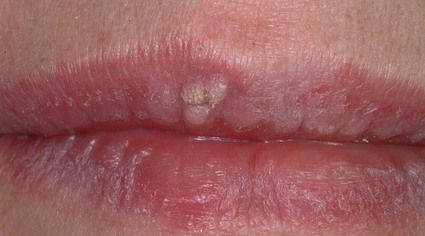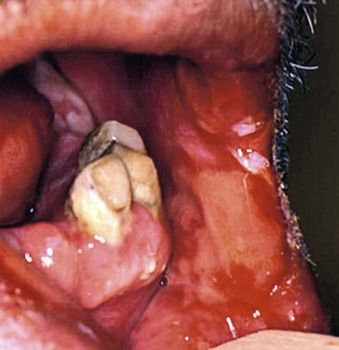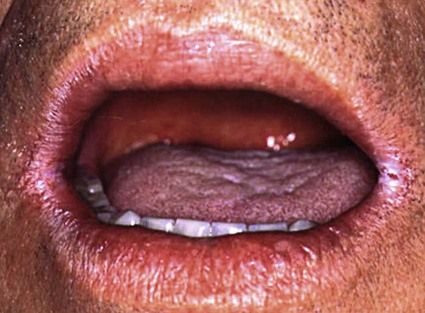Iatrogenic conditions
An increasing number of therapeutic procedures important in modern medicine and surgery can produce iatrogenic (doctor-induced) unwanted orofacial complications (Tables 4.1–4.6).
Immunosuppressive therapy
Immunosuppressive therapy is designed to suppress T lymphocyte function, and leads to immunoincompetence and liability to infections, especially with viruses (Figures 4.1–4.3), fungi (Figure 4.4) and mycobacteria (Table 4.1).
Table 4.1
Orofacial complications of immunosuppression
| Viral infections | Herpesviruses (HSV, VZV, CMV, EBV, KSHV) and human papillomaviruses (HPV) |
| Fungal infections | Usually with Candida species but also deep mycoses (e.g. zygomycosis, histoplasmosis) |
| Bacterial infections | Especially with tuberculosis and other mycobacterial infections |
| Virally related malignant disease | Kaposi sarcoma, lymphomas, carcinomas |
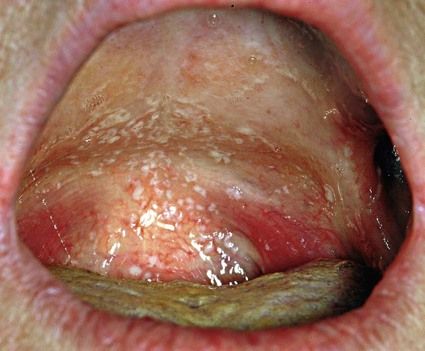
Such infections may spread rapidly; may be opportunistic; and may be clinically silent or atypical.
Radiotherapy
Radiation therapy is widely used, especially to control malignant neoplasms, and if involving the mouth and salivary glands invariably produces complications (Table 4.2). These complications may be minimized by using:
Table 4.2
Orofacial complications of radiotherapy
| Condition | Causes | Comments |
| Mucositis | After external beam radiotherapy involving the maxillofacial tissues | Dose-dependent diffuse erythema and ulceration after 10–15 days (Figure 4.5) |
| Hyposalivation | Damage to salivary glands | (Figure 4.6) Can lead to dysphagia, disturbed taste, candidosis, sialadenitis and radiation caries |
| Osteoradionecrosis | Pain, jaw necrosis and infection | |
| Trismus | Inflammation and scarring | Distinguish from tumour spread |
| Taste loss | Damage to taste buds | Temporary |
| Telangiectasia | Late | |
| Jaw and tooth hypoplasia | Abnormal development | Children treated for neuroblastoma are at particularly high risk |
| Facial palsy | Carotid artery damage | Cerebrovascular event (stroke) |
Chemotherapy
Chemotherapy is widely used, especially to treat lymphoproliferative conditions and malignant neoplasms. There can be several complications (Table 4.3). Mucositis is an almost invariable complication and may also be a predictor of gastrointestinal toxicity and of hepatic veno-occlusive disease. It is caused by cisplatin, etoposide, fluorouracil and melphalan, mucositis is especially seen with chemo-radiotherapy regimens, involving:
Table 4.3
Orofacial complications of chemotherapy
| Condition | Causes | Comments |
| Mucositis | Cytotoxic drugs impair the mucosal barrier and immunity | Pain appears within 3–7 days, mucosa reddens and thins, may slough and become eroded and ulcerated and sometimes bleeds. Erosions/ulcers often become covered by a yellowish white fibrin clot termed a pseudomembrane |
| Taste sensation changed | poor oral hygiene, gastric reflux, infections, drugs | Often temporary |
Organ transplantation
Transplant recipients are treated with immunosuppressive therapy designed to suppress T lymphocyte function, and they therefore have an increased risk of infections and some malignant neoplasms (Table 4.4).
Table 4.4
Orofacial complications of organ transplantation
| Viral infections | Herpesviruses (HSV, VZV, CMV, EBV, KSHV) and human papillomaviruses (HPV), |
| Fungal infections | Usually with Candida species but also deep mycoses (e.g. zygomycosis, histoplasmosis) |
| Bacterial infections | Especially with tuberculosis and other mycobacterial infections. Bacterial sepsis is the most common cause of deaths occurring during the first post-transplantation months |
| Virally related malignant disease | Kaposi sarcoma, lymphomas, carcinomas, post-transplant lymphoproliferative disease |
Haematopoietic stem cell transplantation
Haematopoietic stem cell transplantation (HSCT or bone marrow transplant) is increasingly used to treat haematological conditions, neoplasms and some genetic defects. Patients are first profoundly immunosuppressed to minimize graft rejection by ‘conditioning’, often using cyclophosphamide, plus total body irradiation (TBI), or busulphan and are thus very susceptible to infections. Patients must be isolated and may require transfusions of granulocytes, platelets, red cells, granulocyte colony stimulating factors and antimicrobials until the donor bone marrow is functioning. HSCT may be complicated by mucositis, infections, neoplasms, bleeding, or graft-versus-host disease (GvHD) (Table 4.5).
Table 4.5
Orofacial complications of haematopoietic stem cell transplantation
| Condition | Causes | Comments |
| Mucositis | Cytotoxic drugs impair the mucosal barrier and immunity | Pain appears within 3–7 days, mucosa reddens and thins, may slough and become eroded and ulcerated and sometimes bleeds. Erosions/ulcers often become covered by a yellowish white fibrin clot termed a pseudomembrane |
| Bleeding |
Stay updated, free dental videos. Join our Telegram channel
VIDEdental - Online dental courses
 Get VIDEdental app for watching clinical videos
Get VIDEdental app for watching clinical videos

|
